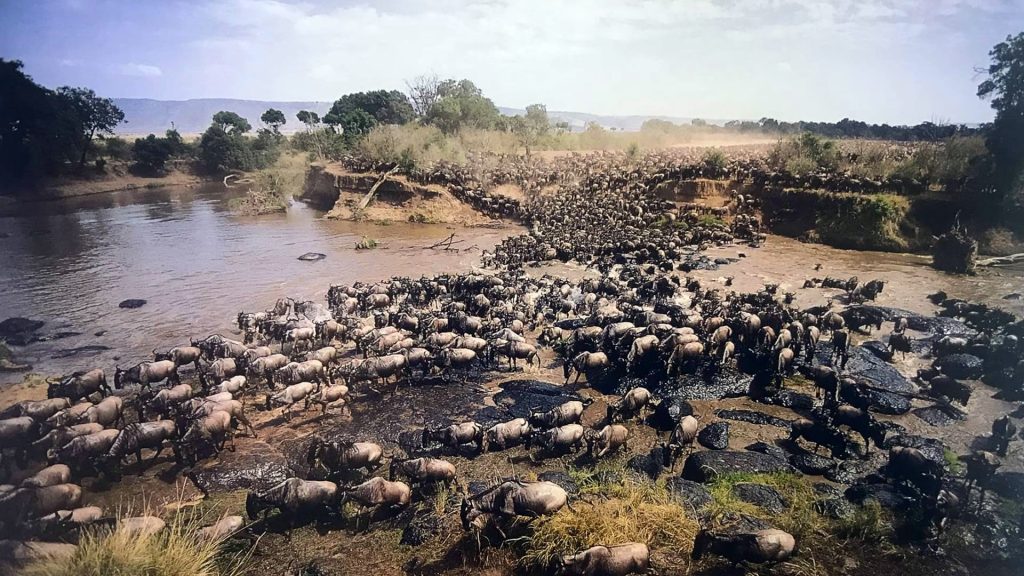
The best time to see the wildebeest migration depends on which specific event you want to witness. For calving season, visit between January and March in the southern Serengeti.
To see dramatic river crossings, plan your trip between July and October when herds cross the Mara River.
Peak migration season occurs during July and August when massive herds form in the northern Serengeti and Maasai Mara. Each period offers unique wildlife viewing opportunities based on the migration’s cyclical nature.
- December-March: Southern Serengeti – Short rains, calving season
- April-May: Central and Western Serengeti corridors – Long rains begin
- June-July: Northern Serengeti – Dry season pushes herds north
- August-October: Masai Mara in Kenya – Northern dry refuge
- November: Back to southern Serengeti – Short Rains Begin
Picture this: 1.5 million wildebeest, 200,000 zebras, and thousands of gazelles moving as one massive organism across the Serengeti plains. This isn’t sci-fi, it’s real life on the African savanna safari.

What drives this many animals to move together? Simple survival. They’re chasing the rains and the fresh grass that follows. It’s nature’s way of ensuring these grazers don’t deplete any single area’s resources.
B. The Circular Journey: Mapping the 1,800-Mile Route
The wildbeest migration isn’t just impressive because of its size – the journey itself is epic. These animals travel in a roughly circular pattern covering about 1,800 miles annually.
The route spans from Tanzania’s Serengeti National Park to Kenya’s Masai Mara National Reserve and back again. It’s not a straight shot either – it looks something like this:
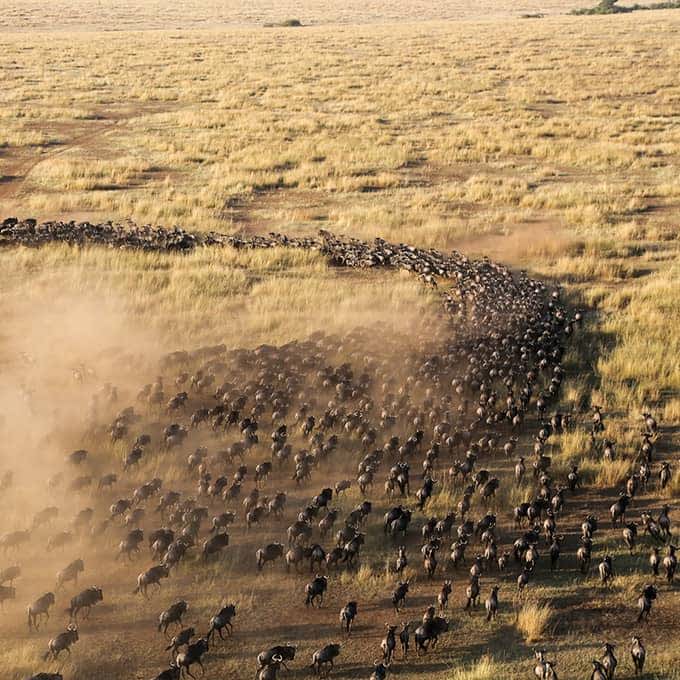
- December-March: Southern Serengeti (calving season)
- April-May: Central and Western corridors
- June-July: Northern Serengeti
- August-October: Masai Mara in Kenya
- November: Back to southern Serengeti
The most dramatic part? River crossings. When thousands of animals plunge into crocodile-infested waters, creating those National Geographic moments everyone wants to witness.
C. Not Just Wildebeest: Other Species That Join the Migration
Think the wildebeest are doing this solo? Think again.
Zebras are the wildebeest’s best travel buddies – around 200,000 join the journey. Their relationship is actually symbiotic: zebras eat longer grass, exposing shorter, more nutritious shoots for the wildebeest.

Thomson’s gazelles tag along too – smaller but just as determined. They benefit from safety in numbers and the predator distraction that comes with traveling in such massive herds.
And where prey goes, predators follow. Lions, cheetahs, leopards, hyenas, and crocodiles all track the migration, creating a moving ecosystem of life and death. For these hunters, wildbeest migration season is basically an all-you-can-eat buffet.
Even birds get in on the action – oxpeckers ride on the backs of mammals, eating parasites, while vultures and marabou storks follow, waiting for their chance at leftovers.
Why the Wildbeest Migration Happens
Following the Rains: The Search for Fresh Grazing
Ever watched a hungry crowd rush to a newly opened buffet? That’s basically what wildebeests do, but on a much grander scale. These animals aren’t just wandering aimlessly – they’re following the rains with a single-minded purpose: food.
When the short rains hit Tanzania’s southern Serengeti National Park around November, the plains transform into a lush green buffet. Wildebeests know exactly where to be for this feast. They’ve got an almost supernatural ability to sense rainfall patterns from over 50 kilometers away. Their noses can literally smell water in the air!
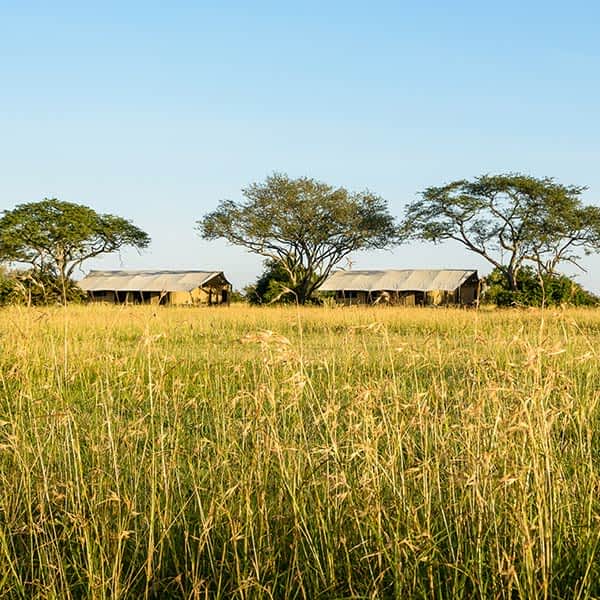
But here’s the kicker – these Serengeti grasslands don’t stay green forever. Once the herds munch through an area or the rains move on, it’s time to pack up and follow the clouds. It’s a never-ending dinner chase across two countries.
B. Evolutionary Adaptation and Survival Instincts
The migration isn’t just some random behavior – it’s hardwired into wildebeest DNA after thousands of years of evolution.
These animals have developed specialized digestive systems that can process young, nutritious grasses quickly. Unlike other grazers who can munch on tougher vegetation, wildebeests need the tender stuff. So when one area dries up, they don’t have the luxury of sticking around.
Their calving is perfectly synchronized too. About 80% of females give birth within the same three-week window in February. This isn’t coincidence – it’s strategic. The southern Serengeti’s short-grass plains provide the perfect nutrient-rich milk-producing food for nursing mothers, while the synchronized births overwhelm predators who can only eat so many newborns.
C. The Annual Cycle and Seasonal Triggers
The migration follows a clockwork pattern that would make Swiss watchmakers jealous:
| Season | Location | Trigger |
|---|---|---|
| Dec-Mar | Southern Serengeti | Short rains, calving season |
| Apr-May | Central & Western Serengeti | Long rains begin |
| Jun-Jul | Northern Serengeti | Dry season pushes herds north |
| Aug-Oct | Masai Mara (Kenya) | Northern dry refuge |
| Nov | Back to Southern Serengeti | Short rains return |
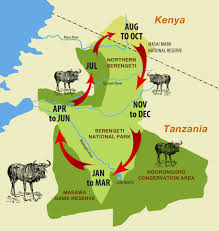
Day length changes, barometric pressure shifts, and distant thunderstorms all serve as environmental cues. When you see wildebeests all suddenly looking in the same direction, they’re not being dramatic – they’re responding to these subtle signals that humans often miss.
D. Climate Change Impacts on Migration Patterns
The migration has hummed along for millennia, but now climate change is throwing wrenches into this finely-tuned machine.
Rainfall patterns are becoming increasingly unpredictable. When rains come too early, too late, or not at all, the wildebeests’ internal GPS gets confused. Some herds have started splitting from traditional routes, creating smaller, fragmented migrations.
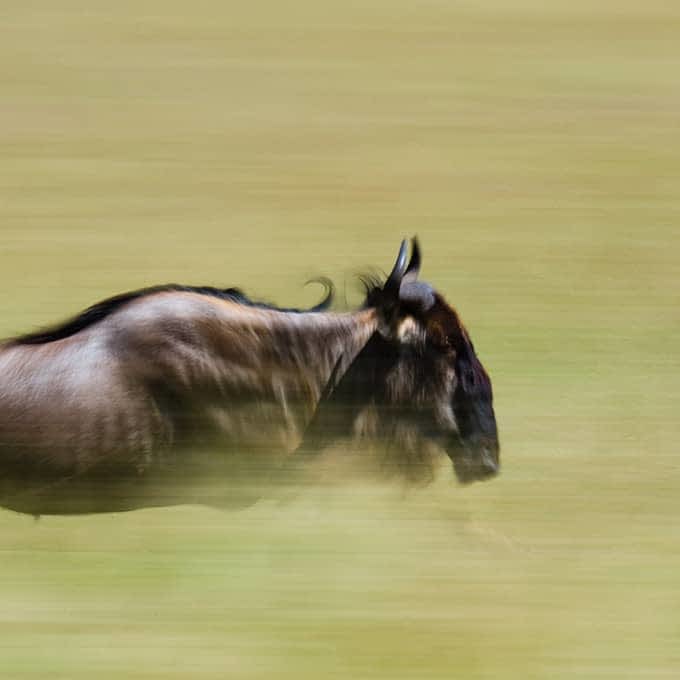
Droughts hit particularly hard. The 2009 drought in Kenya killed nearly 80% of the wildebeests that had crossed into the Masai Mara. Rivers that were once seasonal obstacles now sometimes remain dry, while others flood unexpectedly.
Human development complicates things further. New roads, fences, and settlements are blocking traditional routes, forcing herds to find detours or face dangerous bottlenecks where predators wait.
Key Stages of the Great Wildbeest Migration
A. Calving Season: The Miracle of New Life
The magic begins in the southern Serengeti plains. Between January and March, over 500,000 wildebeest calves are born within a stunning 2-3 week window. That’s roughly 8,000 births daily!
Why such perfect timing? The short grass plains offer abundant nutrition from recent rains, crucial for nursing mothers. Plus, synchronized births overwhelm predators – they simply can’t eat all those calves.
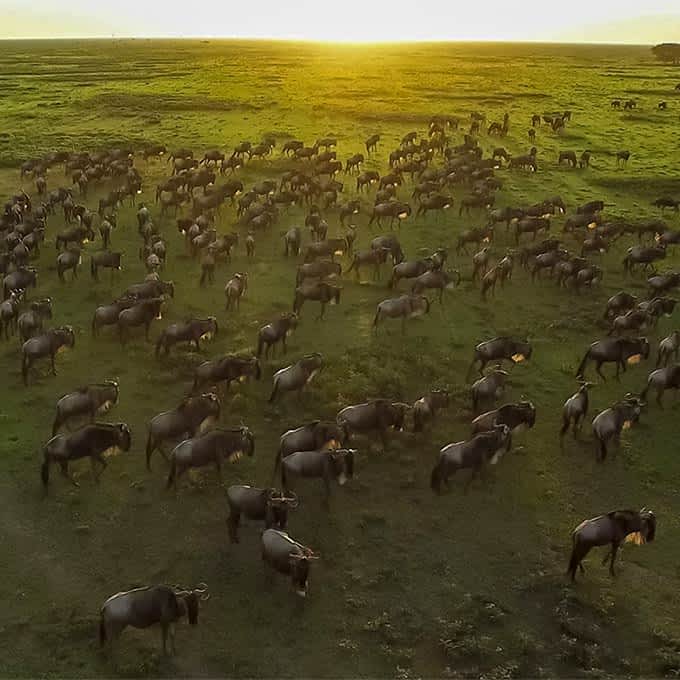
Baby wildebeest hit the ground running – literally. Within minutes, they’re on their feet. Within hours, they can keep pace with the herd. They have to – survival depends on it.
B. River Crossings: Dramatic Battles for Survival
Nothing captures the migration’s raw drama like the river crossings. When thousands of wildebeest reach the Mara River between July and September, they face their greatest challenge.
The first animals arrive at the riverbank and hesitate. Nobody wants to go first. Then suddenly – chaos! One brave soul jumps, triggering a stampede. The water churns brown with bodies while crocodiles strike from below.

The banks become deadly too – slippery mud traps exhausted animals, while lions and hyenas wait patiently for easy meals.
C. Predator Interactions: Nature’s Ultimate Reality Show
The migration creates a moving feast for Africa’s predators. Lion prides strategically position themselves along migration routes. Leopards ambush stragglers from acacia trees. Cheetahs target isolated calves on open plains.
But the most spectacular hunting happens at river crossings, where massive Nile crocodiles – some over 16 feet long – have waited patiently all year for this protein bonanza.

Scavengers follow too. Hyenas trail the herds, picking off the weak and stealing kills. Vultures circle overhead, nature’s cleanup crew.
D. Return Journey: Completing the Circle of Life
By October, the short rains begin in the southern Serengeti, pulling the herds back toward their calving grounds. This southward journey isn’t one straight shot – it’s more like a scattered, gradual drift across the eastern Serengeti.
The animals move with purpose now, pregnant females leading the way. Their bodies somehow know exactly where to go to find the perfect birthing grounds.
E. Timing Variations: Why No Two Migrations Are Identical
The great wildbeest migration follows the rains, not the calendar. Drought years push wildebeest to travel farther in desperate search of grass and water. Heavy rain years might see herds lingering longer in Masai Mara National Reserve in Kenya, specifically along the Mara River .
Climate change is shuffling the deck too. Rangers and guides who’ve watched the migration for decades report shifting patterns – earlier river crossings, delayed calving, new routes being forged.
This unpredictability is exactly what makes witnessing the migration so special. You’re not seeing a programmed event – you’re watching wild animals making real-time survival decisions.
Best Locations to Witness the Wildbeest Migration
Tanzania’s Serengeti National Park Viewing Points
Nothing prepares you for that first glimpse of thousands of wildebeest dotting the Serengeti plains. The best spot? Grumeti River. Park yourself here during June-July and watch the drama unfold as herds make death-defying river crossings while crocodiles wait patiently.

Seronera Valley offers year-round viewing with its permanent water sources. The kopjes (rocky outcrops) here give you that perfect elevated vantage point – bring binoculars and thank me later.
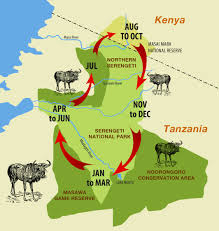
For the ultimate migration experience, head to Moru Kopjes between January and March. The wildebeest calving season brings new life and, naturally, predators looking for an easy meal. Circle of life right before your eyes.
Kenya’s Masai Mara National Reserve Hotspots
The Mara River crossings are the stuff of National Geographic documentaries. Sand River and Talek River crossings offer front-row seats to the most spectacular wildlife show on earth. August through October is prime time.
Paradise Plains lives up to its name with sweeping vistas where you can spot the migration from miles away. The predator concentration here is insane – lions, cheetahs, and leopards all cashing in on the wildebeest buffet.
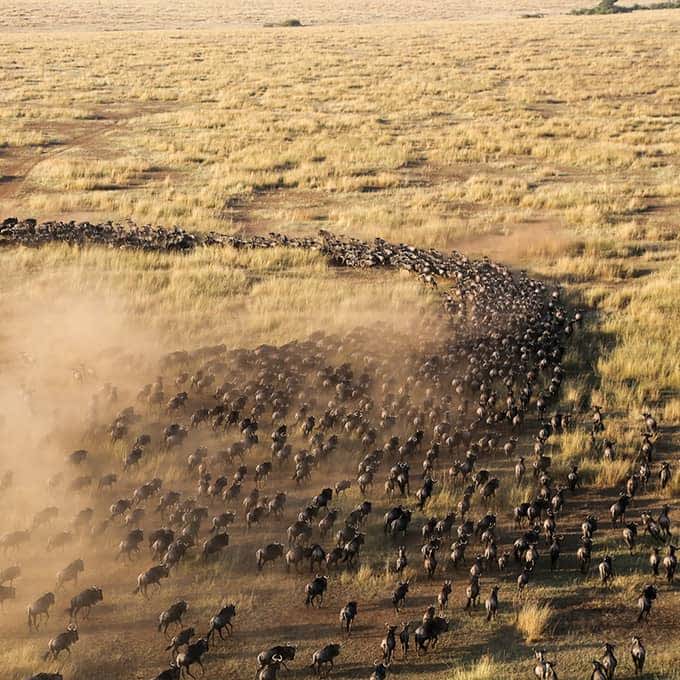
Governors’ Camp area combines luxury with prime viewing. Sip your morning coffee as thousands of animals thunder past your tent. Not a bad way to start the day, right?
Lesser-Known Observation Areas for Avoiding Crowds
Sick of jostling with twenty other safari vehicles? Try these hidden gems.
The Northern Serengeti near Kogatende offers spectacular river crossings without the tourist crush. The Lamai Wedge area feels like your private wildlife show.
Lobo Valley in Tanzania stays under the radar despite offering incredible migration views during October-November. The landscape here – rolling hills meeting endless plains – adds another dimension to your photos.
The Mara Conservancies bordering the main reserve provide exclusive access with strict vehicle limits. Worth every penny for the solitude.
Choosing the Right Season for Your Visit
Timing is everything with the wildbeest migration. It’s constantly moving in a clockwise loop through Tanzania and Kenya.
December-March: Southern Serengeti National Park for calving season. Two million wildebeest babies can’t be wrong.
April-June: Western Corridor as herds begin moving north. River crossings without the crowds.
July – October: This is when the wildebeest are most likely to be crossing the Mara River, a particularly dramatic and sought-after spectacle. Book early – like, a year early.
November: Eastern Serengeti as herds begin their southern journey again. Often overlooked but magical.
Capturing the Wildbeest Migration Experience
Photography Tips for Spectacular Wildlife Shots
Ever tried capturing a million wildebeest thundering across a river? It’s like photographing a moving mountain. Here’s how to nail those shots:
- Go long: Bring a telephoto lens (at least 300mm) to capture distant action without disturbing animals
- Pack for dawn and dusk: The golden hours offer magical lighting when animals are most active
- Patience beats luck: Find a good spot and wait—the best shots come to those who don’t chase them
- Shoot in bursts: Wildlife moves fast, so use continuous shooting mode to catch the perfect moment
- Get low: Whenever possible, photograph at eye level with the animals for more intimate shots
Forget the perfect settings—this isn’t a studio shoot. Be ready to adjust quickly as light changes dramatically throughout the day.
Here is our what to wear on a safari article.
Ethical Viewing Practices for Responsible Tourism
The migration isn’t a circus act—it’s nature at its rawest. Your actions matter:
- Keep your distance. Vehicles crowding crossing points stress animals and cause drownings
- Silence is golden. Loud voices and music disrupt natural behaviors
- Take nothing but photos, leave nothing but tire tracks
- Follow your guide’s instructions—they know when you’re too close
- Never pressure drivers to go off-road or break park rules for a better view
Remember that photo you’re desperate for? It’s not worth an animal’s life. When dozens of safari vehicles converge at river crossings, some drivers get reckless. Don’t be that tourist who demands they push limits.
Safari Options: From Budget to Luxury Experiences
The wildbeest migration isn’t just for the wealthy. Options exist for every wallet:
Budget-Friendly
- Shared group safaris with fixed departures
- Public campgrounds with basic facilities
- Local tour operators often beat international prices
Mid-Range
- Private vehicles with experienced guides
- Permanent tented camps with proper beds and bathrooms
- Mobile camps that follow the migration
Luxury Options
- Exclusive-use areas away from crowds
- Private guides and customized itineraries
- Helicopter excursions for aerial views
- Luxury lodges with gourmet dining and infinity pools
The real luxury during migration season? Location. Being near prime crossing points beats any thread-count or champagne breakfast.
Conservation Efforts That Support the Migration
This ancient spectacle faces modern threats. Supporting these efforts helps ensure it continues:
- Anti-poaching units patrol both Kenya and Tanzania to protect wildlife corridors
- Community conservation areas create buffer zones that prevent development in critical areas
- Research programs track migration patterns as climate change shifts traditional routes
- Tourism fees directly fund park maintenance and wildlife protection
Your safari choices matter. Operators that donate to conservation efforts, employ local guides, and follow strict environmental practices deserve your business over those merely chasing profits.
The ultimate souvenir from your migration experience isn’t that perfect photo—it’s knowing you’ve witnessed something ancient and helped it survive for future generations.
The Great Wildebeest Migration
The great wildebeest migration stands as one of nature’s most awe-inspiring spectacles, where over a million animals traverse the Serengeti-Mara ecosystem in search of fresh grazing and water. Understanding the ecological drivers behind this circular journey and its key phases—from calving in the southern Serengeti to the dramatic river crossings and the return southward—helps appreciate the true marvel of this natural phenomenon. The best viewing locations, including the Central Serengeti National Park, Grumeti River, and Mara River, each offer unique perspectives on different stages of this incredible journey.
Whether you’re an aspiring wildlife photographer or simply a nature enthusiast, witnessing the migration firsthand is a transformative experience. As these magnificent animals continue their ancient cycle despite increasing environmental challenges, their journey reminds us of nature’s resilience and the importance of conservation efforts to preserve this spectacular wildlife event for future generations. Plan your safari during the right season, respect wildlife viewing guidelines, and prepare to be humbled by one of Earth’s greatest natural wonders.

Leave a Reply